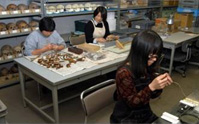
Click here for PC version
Click here for Smartphone version
- Department of Zoology
- Department of Botany
- Department of Paleontology and Anthropology
- Department of Science
- Tsukuba Botanical Garden
- Institute for Nature Study
- Center for Collections
- Center for Molecular Biodiversity research
- Showa Memorial Institute
- Center of the History of Japanese Industrial Technology


Researchers work on the measurement and restoration of human skeletal remains.
The Department of Paleontology and Anthropology utilizes collections encompassing fossils, archaeological human remains, and hominid replicas to conduct research on the origin and evolution of all life on Earth. Taken together, these specimens and their associated data span approximately 3.5 billion years of evolutionary history. Our three research divisions share the work of investigating and curating these collections. We collaborate with other departments within the museum to conduct both comprehensive interdisciplinary research projects and so-called “concentrated studies” that focus on specific themes. Information from the specimens and materials in our collections is compiled into a database for use in research, education, and exhibition.
The Division of Evolutionary Paleobiology conducts research on the systematics, taxonomy, evolution, paleobiogeography, and paleoecology of plants and animals. Our current staff members specialize in the phytogeography and floral transition of eastern Eurasia and South America; the evolution of Mesozoic reptiles in Asia and the Americas; the phylogeny, paleoecology, and evolutionary functional morphology of Cenozoic mammals; the phylogeny, behavioral evolution, and motor and sensory system evolution of Cenozoic reptiles; and the phylogeny and adaptive radiation of marine mammals.
The Division of Paleoenvironment and Paleoecology conducts research on the history of global environmental changes and the evolution of ecosystems. Current members specialize in the reconstruction of Cenozoic marine and lake environments in the Pacific region using microfossils such as diatoms and foraminifera, the origin and transition of molluscan diversity in the Western Pacific region, and the Mesozoic stratigraphy and evolution of cephalopods in the Pacific Rim. In addition, the Micropaleontological Reference Center stores microfossil specimens collected by international ocean drilling programs including DSDP and IODP.
The Division of Anthropology conducts morphological, molecular, and bioarchaeological research using collections of a wide range of anthropological specimens to elucidate the origin and evolution of humans and their microevolution, migration, and adaptation to the Japanese archipelago. These collections consist mainly of human skeletal remains excavated from various archaeological sites in Japan. In addition to these remains, this division also handles various specimens related to humans, such as hominid casts from other institutions, animal bones, mummified specimens, and replicas of archaeological artifacts such as stone and bone tools.






